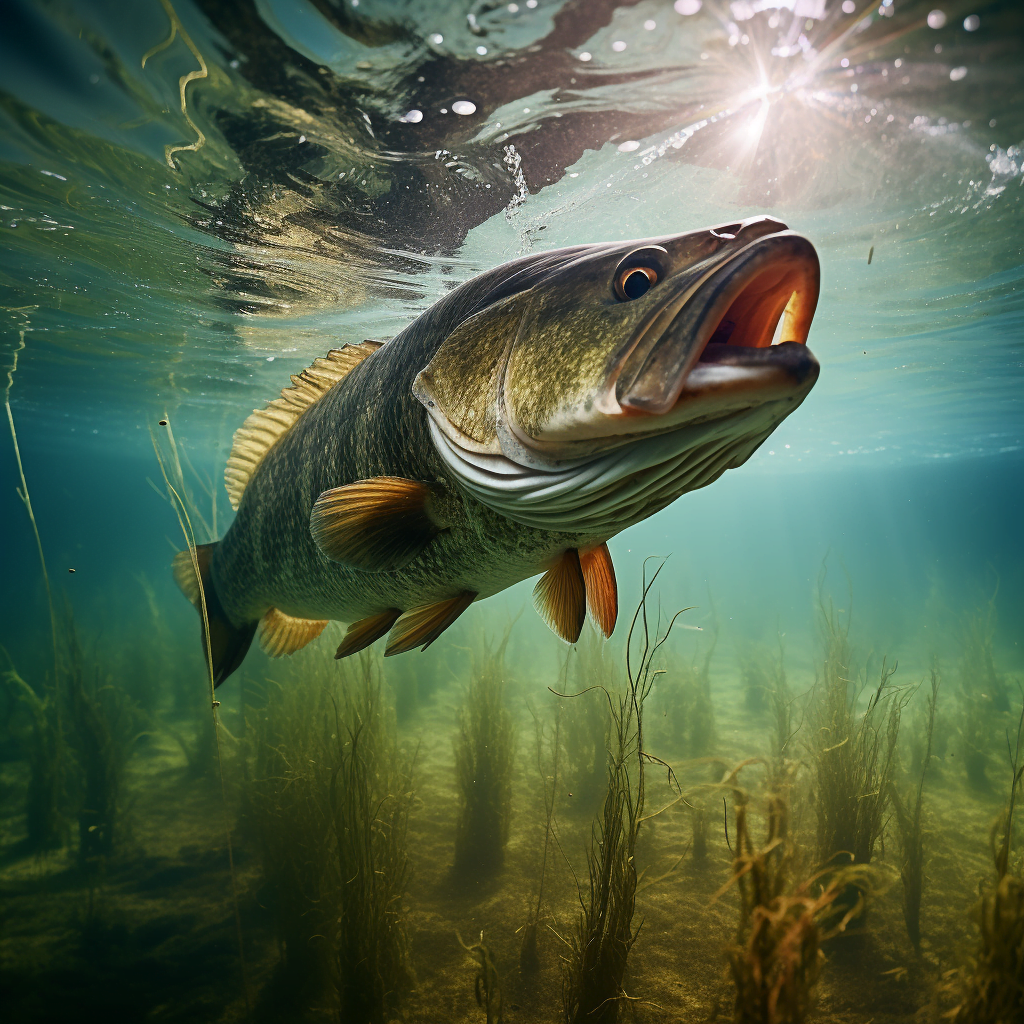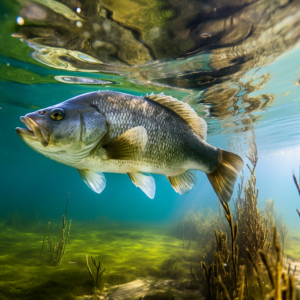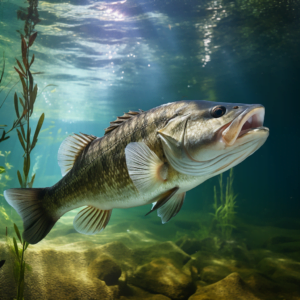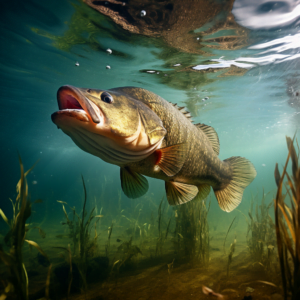If you’ve ever pondered the question of how to attract largemouth bass effectively, you’re not alone. Every angler, from beginners to seasoned professionals, knows that the key to a successful catch lies in understanding your target—knowing what attracts them and, equally important, what doesn’t. In this comprehensive guide, we’re diving deep into the olfactory world of one of the most sought-after game fish, the largemouth bass. We unveil the secret scents that make a difference in your fishing game, drawing these creatures right into your path, and boosting your overall fishing success.
Largemouth bass are creatures of instinct, and their behavior is significantly influenced by their sensory environment. Beyond the visual appeal of your lures, it’s the scents that can make all the difference between a day of victory or disappointment on the water. So, let’s explore how to attract largemouth bass by unlocking the potent power of scents, providing you with practical insights and effective strategies to become a magnet for these prized catches. By the end of this article, the mystery of what draws largemouth bass to your hook will be a secret no more. Welcome to the ultimate guide to transforming your approach and making every fishing expedition an adventure teeming with potential.
The Secret Scent: How to Attract Largemouth Bass
When it comes to catching largemouth bass, many anglers are familiar with the importance of using the right lures, rods, and reels. However, one often overlooked factor that can greatly enhance your chances of success is the use of scents. Largemouth bass have a highly developed sense of smell, and by understanding the scents that attract them, you can significantly improve your fishing game. In this article, we will explore the secrets of using scents to attract largemouth bass and provide you with valuable insights and techniques to maximize your fishing success.
| Scent Type | Best Season to Use | Effectiveness (1-5) | Notes on Usage |
|---|---|---|---|
| Anise Oil | Spring/Summer | 5 | Highly attractive, especially during pre-spawn when bass are more active. |
| Garlic | All Seasons | 4 | Universal appeal, good for all seasons. Potent, so use sparingly. |
| Shrimp | Summer/Fall | 3 | Best used in waters where crustaceans are natural prey for bass. |
| Live Bait (e.g., minnows, crayfish) | All Seasons | 5 | Simulates natural prey, highly effective. Check local regulations for usage. |
| Artificial Scent Gels | All Seasons | 4 | Long-lasting, good for waters with current. Variety available mimicking different prey species. |
| Decaying Matter | Summer | 2 | Can attract bass in some environments, but has the potential to attract unwanted species. |
Understanding the Largemouth Bass’s Sense of Smell
Before we dive into the different scents that attract largemouth bass, it is essential to understand how their sense of smell works. Largemouth bass have a highly sensitive olfactory system, which allows them to detect and differentiate various scents in the water. They possess an organ called the olfactory epithelium, located in their nasal passages, that is packed with receptors specifically designed to detect chemical cues in the water.
Research has shown that largemouth bass can detect and interpret scents from a variety of sources, including food, predators, and potential mates. They rely on their sense of smell to locate and target prey, navigate their environment, and communicate with other fish. By tapping into this powerful sense, anglers can increase their chances of attracting and hooking largemouth bass.
Choosing the Right Type of Scent for Largemouth Bass
When it comes to selecting scents for largemouth bass, there are two main categories to consider: natural and artificial scents.
Natural scents refer to substances that occur naturally in the environment and can be found in various types of bait. For example, the scent of live bait such as worms, minnows, or crawfish can be highly attractive to largemouth bass. These scents mimic the natural prey that bass feed on and can trigger their predatory instincts.
On the other hand, artificial scents are specifically designed to mimic or enhance natural scents. These scents often come in the form of gels, sprays, or liquids that can be applied to lures or bait. Artificial scents can be highly effective in attracting largemouth bass, especially in situations where natural bait is not readily available or allowed.
Natural and Artificial Scents for Largemouth Bass Fishing
When it comes to natural scents, live bait is hard to beat. Largemouth bass are opportunistic feeders and are naturally drawn to the smell and movement of live prey. Using live bait such as worms, minnows, or crayfish can lead to increased strikes and more successful hook-ups.
In addition to live bait, there are various natural scents that you can utilize to attract largemouth bass. For example, anise oil, garlic, and shrimp scents have been known to be effective in enticing bass. These scents can be applied to lures, soft plastics, or even used as an attractant to enhance the scent of live bait.
When it comes to artificial scents, there are countless options available on the market. From fish-attracting gels to scent-impregnated soft plastics, the choices can be overwhelming. The key is to experiment and find scents that work well in your fishing area and under local conditions. What works in one lake or river may not be as effective in another, so be open to trying different scents until you find the ones that produce the best results.
Using Live Bait as an Effective Scent Attractor
As mentioned earlier, live bait is one of the most powerful scent attractors for largemouth bass. The smell and movement of live bait can trigger the predatory instinct of bass, making them more likely to strike. When using live bait, it is essential to present it in a natural and appealing way. Proper hook placement, realistic movement, and the right scent can make all the difference.
One effective technique is to thread live bait onto a hook, allowing it to swim freely in the water. This natural presentation can be highly enticing to largemouth bass, as it mimics the behavior of their natural prey. Adding a scent attractant to the live bait can further enhance its effectiveness, increasing the chances of attracting bass.
Differentiating Between Attractive and Repellent Scents
While scents can be a powerful attractant for largemouth bass, it is crucial to be aware that not all scents are created equal. Some scents can actually repel fish and drive them away. Therefore, it is essential to differentiate between attractive and repellent scents to ensure you are using the right ones.
One way to determine attractive scents is to observe the natural environment of the bass’s habitat. Pay attention to the scents that are present, such as the smell of vegetation, decaying matter, or other natural prey. By using scents that mimic these natural odors, you can tap into the bass’s instinctive response to potential food sources.
On the other hand, certain scents can signal danger to largemouth bass and cause them to avoid an area. For example, strong chemical odors, such as gasoline or sunscreen, can be highly repellent to fish. Similarly, scents that are too overpowering or unnatural may also have a negative impact on bass behavior. It is crucial to choose scents that are subtle, natural, and appealing to the fish.
Identifying the Best Seasonal Scents for Largemouth Bass
The effectiveness of scents for largemouth bass can vary depending on the season. By understanding the seasonal patterns of bass behavior and their preferred prey, you can choose the most appropriate scents to use throughout the year.
In the spring, as largemouth bass emerge from their winter hiding spots and become more active, they can be highly responsive to scents that mimic the smell of spawning fish. At this time, scents such as shad, bluegill, or crawfish can be particularly effective in attracting bass.
During the summer months, when the water temperature warms up, largemouth bass tend to seek out deeper, cooler waters. This is where scents that imitate the smell of baitfish or crayfish can be effective in enticing bass to strike. Additionally, scents that create a trail in the water can be beneficial, as they help fish locate the bait even in low visibility conditions.
As fall approaches and water temperatures begin to cool down, largemouth bass become more voracious in their feeding habits. At this time, scents that mimic injured or dying prey can be highly appealing to bass. By creating the illusion of an easy meal, you increase the chances of triggering a strike.
In winter, when largemouth bass are less active and more sluggish, scents can still play a role in attracting them. However, it is vital to choose scents that are particularly potent and long-lasting in cold water conditions. Garlic, anise, or potent fish scent gels can be effective options to consider.
Enhancing Scent Attraction with Color and Texture
While scents alone can be effective in attracting largemouth bass, combining them with attractive colors and textures can further enhance their effectiveness. Largemouth bass are visual hunters and are attracted to objects that stand out in their environment.
One effective strategy is to choose lures or bait that have contrasting colors or vibrant patterns. The combination of an enticing scent with an eye-catching design can increase the chances of bass detecting and striking at your offering. Additionally, experimenting with different textures, such as soft plastics with lifelike movement, can make your bait more appealing and increase its likelihood of being targeted by bass.
Utilizing Scent Dispersion Techniques for Greater Success
To maximize the effectiveness of scents, it is crucial to understand how they disperse in the water. Proper scent dispersion can increase the range at which bass can detect the scent and improve your chances of attracting them.
One technique to enhance scent dispersion is to use scented attractants that are designed to release scent gradually over an extended period. These attractants can be applied to lures or soft plastics, allowing the scent to be continuously released as the bait moves through the water. This slow release of scent creates a trail that bass can follow, increasing the likelihood of a strike.
Another effective method is to use scent dispersal tools such as scent wicks or scent bombs. These devices are designed to hold scent attractants and can be attached to fishing lines or placed in strategic locations to disperse the scent effectively. By dispersing the scent over a larger area, you can attract bass from a greater distance and improve your chances of success.

The Role of Water Temperature in Effective Scent Attraction
Water temperature plays a significant role in the effectiveness of scents for attracting largemouth bass. As water temperature fluctuates throughout the year, so does the behavior and feeding patterns of bass. Understanding these temperature-related changes can help you choose the most appropriate scents for each season.
In warmer water temperatures, between 65°F and 80°F, bass are more active and their metabolic rate increases. This higher metabolic rate means that bass are more likely to seek out and respond to scents. Therefore, using scents that imitate the smell of natural prey can be highly effective in enticing bass to strike.
In colder water temperatures, below 65°F, bass become more lethargic and less responsive to scents. At these lower temperatures, it is important to choose scents that are particularly potent and long-lasting to ensure they are effective. Additionally, slowing down your retrieval speed can also increase your chances of success as bass are less likely to chase after fast-moving prey during colder months.
Avoiding Common Mistakes in Using Scents for Largemouth Bass
While using scents can significantly increase your chances of attracting largemouth bass, there are a few common mistakes that anglers make when using scented attractants. By being aware of these mistakes and taking measures to avoid them, you can maximize your success on the water.
One common mistake is using too much scent. While it may be tempting to apply large amounts of attractant to your bait, this can actually have a negative effect. Bass have a keen sense of smell and can be easily overwhelmed by strong scents. Using a moderate amount of attractant is often more effective in attracting bass without driving them away.
Another mistake is not reapplying the scent regularly. Over time, scents can dissipate in the water or wash away, reducing their effectiveness. It is essential to reapply attractants periodically, especially in situations where you are fishing for an extended period or in fast-moving water.
Finally, it is important to choose scents that are appropriate for the fishing conditions and the specific species you are targeting. Different species have different scent preferences, and what may attract largemouth bass may not work as effectively for other fish. Furthermore, pay attention to the water clarity, temperature, and the available food sources in the area to make informed decisions about which scents to use.
Experimenting with Novel Scents to Maximize Attraction
As with any aspect of fishing, experimentation is key to discovering what works best for you in attracting largemouth bass. While there are tried and true scents that have proven to be effective, don’t be afraid to try something new or different.
Manufacturers are continually developing new scents and attractants, each claiming to be the next big thing. By keeping an open mind and trying out these new scents, you may stumble upon a game-changer that revolutionizes your fishing experience. Whether it’s a new combination of scents or a novel attractant formulation, exploring new options can lead to exciting discoveries.
The Importance of Proper Storage and Maintenance of Scents
To ensure the effectiveness of scented attractants, it is crucial to store and maintain them properly. Improper storage can lead to the degradation of scents and reduce their potency over time. To prevent this, there are a few essential guidelines to follow.
Firstly, it is important to store scents in a cool and dry place, away from direct sunlight. Exposure to heat and UV light can break down the scent compounds and render them less effective. Additionally, make sure to seal the containers tightly to prevent any leakage or evaporation of the scents.
Secondly, it is advisable to check the expiration dates on scented attractants. Over time, scents can lose their potency and become less effective. By regularly replacing old or expired attractants, you can ensure that you are using the freshest and most potent scents available.
Finally, it is essential to keep your scents separate and avoid cross-contamination. Mixing scents can result in undesirable combinations and reduce their effectiveness. It is best to keep each scent in its own container and avoid mixing scents or using the same tools with different scents.
Employing Scent Attraction Strategies in Different Fishing Environments
Largemouth bass can be found in a variety of fishing environments, from lakes and rivers to ponds and reservoirs. Each fishing environment presents its own unique challenges and opportunities when it comes to using scented attractants effectively.
In stillwater environments such as lakes or ponds, scent dispersal can be a bit more challenging. The lack of current makes it harder for scents to spread, limiting their range of effectiveness. In this case, it is crucial to focus on applying scents directly to your bait or lures and using attractants that release scent gradually over an extended period. This ensures that the scent is continuously being released, increasing the chances of a bass encountering it.
In flowing water environments, such as rivers or streams, scent dispersal is more natural due to the current. However, it is important to consider the flow rate of the water and adjust your technique accordingly. In swift currents, scents can be quickly washed away, reducing their effectiveness. In these situations, using attractants that adhere to the bait or lures, such as gels or dips, can be more effective in ensuring that the scent remains in the water column for a longer period.
Conclusion: Unleashing the Power of Scent to Catch More Largemouth Bass
In wrapping up, mastering how to attract largemouth bass involves an astute application of various scents, acknowledging the profound role they play in the art of angling. This journey takes us beyond the conventional tools of rods, reels, and lures, plunging us into the intricate world of olfactory attraction and the responses it triggers in these aquatic predators.
Experimentation is your ally in this venture, urging you to try an array of scents, both natural and synthetic, and observe the largemouth bass’s reactions. The nuances of water temperature, seasonal changes, and bass behavioral patterns all inform the strategic choices you make, enhancing each fishing expedition’s potential.
But remember, the secret doesn’t just lie in knowing which scents to use; it’s equally about understanding and mastering the presentation. The way scents disperse in the water, how they’re applied to your bait or lures, and even the complementary use of color and texture can dramatically boost your attraction strategy’s effectiveness.
Furthermore, avoid the pitfalls that anglers can encounter. The overuse of scent, neglecting to reapply, and ignoring the specifics of your fishing environment could all undermine your efforts. Educate yourself on these aspects to truly harness and leverage the power of scents.
So, as you stand on the cusp of your next fishing adventure, armed with a variety of aromatic aids, you’re now equipped with more than just basic gear. You possess the knowledge and tactics on how to attract largemouth bass with a nuanced, multi-faceted approach. This isn’t merely fishing; this is a strategic dance with nature, inviting success through insight, patience, and the profound understanding of the largemouth bass’s sensory world. Embrace this wisdom, and let the waters reveal the fruits of your learned endeavors.




